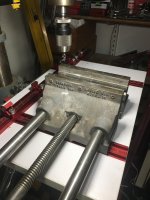rvieceli said:
Make sure you can CLAMP everything down so that it CANNOT move. That includes the piece being cut, the whole jig itself and if it were me I’d also lock down the router too. You do not want anything to be able to move.
Sometimes aluminum can gum up on cutters so you may need to use some kind of lubricant.
Ron
Youth and enthusiasm is a great elixir...however every now and then let's tamp down the enthusiasm with something called experience.
Ron's got this completely correct. Machining metal is completely different than machining wood. If you catch a drill/mill flute in wood you rip out the wood, you duck and it gets flinged it across the room, big deal. If you do the same in metal you can rip off your arm, bigger deal.
If this were my project, and I felt the need to use a 13/16" diameter cutter in aluminum, you absolutely need to lock down the aluminum extrusion you're working on. And I'm not talking about some puny clamps that are leftovers in your garage. You need something substantial.
Here's my approach to securing the material to the drill press.
The 8020 extrusions would be secured in a very substantial and robust vise. Something along the Palmgren, Heinrich or Kurt line will suffice.
Here's a Heinrich that weighs 40# and is a relative lightweight in the group, that will dampen the movement if something goes awry.
[attachimg=1]
I'd then remove the Woodpeckers top from my drill press and BOLT the vise down to the cast iron production drill press table with either 1/2" or 5/8" bolts...this is serious stuff.
Also of note, if you've looked up speed & feed tables for machining aluminum, you'll notice that the optimum speed for a 13/16" diameter cutter in aluminum is 950 RPM. Better dial down that router a bit. [smile]
You'll also definitely need some type of lubricant.
I'm still curious why you're hung up on using a router?

